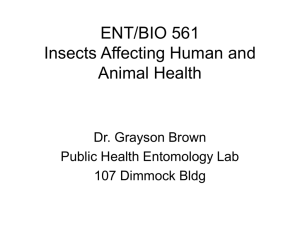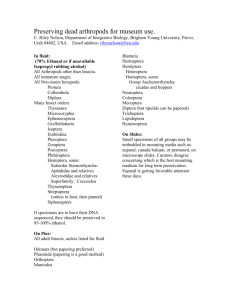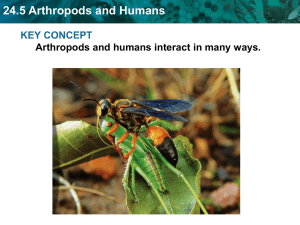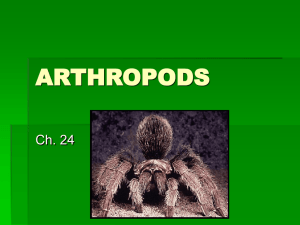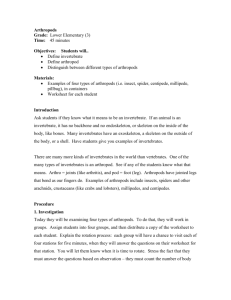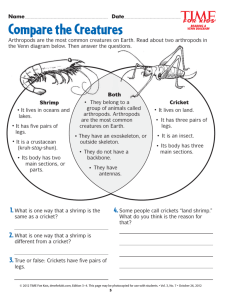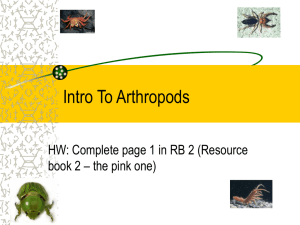University of Jordan - Faculty of Agriculture
advertisement
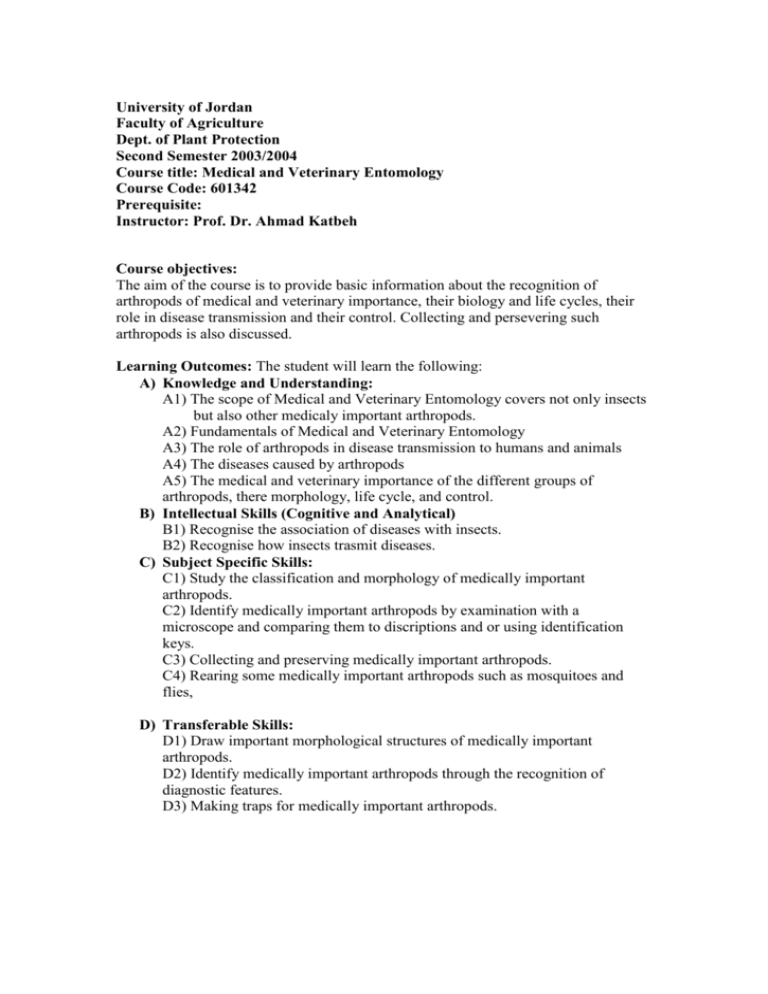
University of Jordan Faculty of Agriculture Dept. of Plant Protection Second Semester 2003/2004 Course title: Medical and Veterinary Entomology Course Code: 601342 Prerequisite: Instructor: Prof. Dr. Ahmad Katbeh Course objectives: The aim of the course is to provide basic information about the recognition of arthropods of medical and veterinary importance, their biology and life cycles, their role in disease transmission and their control. Collecting and persevering such arthropods is also discussed. Learning Outcomes: The student will learn the following: A) Knowledge and Understanding: A1) The scope of Medical and Veterinary Entomology covers not only insects but also other medicaly important arthropods. A2) Fundamentals of Medical and Veterinary Entomology A3) The role of arthropods in disease transmission to humans and animals A4) The diseases caused by arthropods A5) The medical and veterinary importance of the different groups of arthropods, there morphology, life cycle, and control. B) Intellectual Skills (Cognitive and Analytical) B1) Recognise the association of diseases with insects. B2) Recognise how insects trasmit diseases. C) Subject Specific Skills: C1) Study the classification and morphology of medically important arthropods. C2) Identify medically important arthropods by examination with a microscope and comparing them to discriptions and or using identification keys. C3) Collecting and preserving medically important arthropods. C4) Rearing some medically important arthropods such as mosquitoes and flies, D) Transferable Skills: D1) Draw important morphological structures of medically important arthropods. D2) Identify medically important arthropods through the recognition of diagnostic features. D3) Making traps for medically important arthropods. Teaching Methods: Duration: 16 weeks. Lectures: 16 hours, 2 per week. Laboratory: 48 hours, 3 hours per week. Assigments: A collection of medically important arthropods occuring in Jordan is required. Method Objective: Learning outcomes Assessments Teaching Methods Lectures Laboratory A1-A5, B1-B2, C1, C2, D1, D2 Written Exams Practical Exams Field Study C3, C4, D3 Reports and Assignments Exams & Evaluation: 1) First Exams (15 points) 2) Second Exam (15 points) 3) First Lab. Exam (5 points) 4) Final Lab. Exam (10 points) 5) Drawing Book (5 points) 6) Insect Collection and Report (10 points) 7) Final Exam ( 40 points) Course Contents Introduction to medical entomology Introduction to the arthropods of medical and veterinary importance Diptera Culicidae Psychodidae, Ceratopogonidae Simulidae, Tabanida, Glossinidae Muscidae Calliphoridae, Scarcophagidae Cuterebridae, Oestridae, Gastrophilidae Siphonaptera Pulicidae, Leptopsyllidae and Ceratophilidae Phthiraptera Pediculidae and Phthiridae Hemiptera Cimicidae, Reduviidae Blattaria Order Metastigmata, Argasidae, soft tocks Order Metastigmata Ixododae, hard ticks Order Astigmata, Sarcoptidae, Scabies mite Order Prostigmata, Trombiculidae Scrub typhus mite, and Scorpions Text Book Kettle, D. S. 1995. Medical and Veterinary Entomology. 2nd edition. CAB international. Wallingford. UK. 725 pp. 1 hour 1 hour 1 hour 1 hour 1 hour 2 hours 1 hour 1 hour 1 hour 1 hour 1 hour 1 hour 1 hour 1 hour 1 hour References: Amr, Z. 2000. Arthropods of Medical importance in Jordan. United Nations development program. Amman 68 pp. 2000. Herms, W. B. and M. T. James. 1968. Medical entomology. The McMillan Company. New York 616 pp. Lane, R. P. and R. W. Crosskey 1993. Medical insects and Arachnids. Chapman Hall, London. UK. 723 pp. Service, M. W. 1980. A guide to medical entomology. McMillan Press. London. 266 pp. Papers from several journals and internet resourses. Important Regulations: The student is required to present a collection (due one week before the final exam) of the medically important arthropods, especially the ones taken in lectures. Each insect should be pinned or preserved in alcohol or in a slide. It should be labeled with location, date, host, collecter's name, and identification. The label should be printed on lazer printer or written with Indian ink. The collection should be organized in a box according to insect's orders. It should be presented with a report showing number of specimens, a list of orders, families, and identified species.
